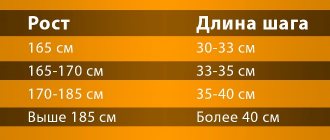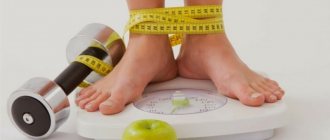Do you know how much walking you need to do per day? The benefits of walking are enormous for everyone, both women and men, everyone knows about this. Getting extra miles every day is very important for your overall health. Scientists have already determined the exact useful number for 24 hours - 10,000 steps. Walking has long been a sport and is divided into types, so you need to have comfortable shoes, a pedometer and a navigator. All that remains is to develop a habit and learn to walk correctly. In this article I will tell you why you should take up daily walking today and not put it off until tomorrow.
It's time to walk
Movement is life. However, in everyday life, not everyone moves every day. You don't have to buy a gym membership right away. A good place to start is walking.
No matter how healthy you are, health must be maintained throughout your life. Lack of movement leads to diseases of the heart, blood vessels, and lungs, as a result of which the period of life is shortened. In addition, lack of physical activity certainly entails weight gain. However, the majority actively refuse, using excuses such as lack of time or lack of motivation.
Physical inactivity negatively affects all organs
But how can we start walking when in the modern world we are always late and dependent on various means of transport - metro, buses, cars, motorcycles. Without which it is impossible to imagine arriving from one point to another. It is known that walking is an accessible, simplest and safest type of physical activity.
There is a trend across Europe of insufficient physical activity. And in the Czech Republic, an observation was carried out from 2008 to 2013, the result showed that the daily number of steps decreased by 850 per day in men and by 1490 in women. It’s worth considering that the time has come to walk more.
Run
During running, almost the same body movements are performed as when walking, but there is a flight phase (moments when the legs do not rest on the surface), and leaning on two legs at the same time is excluded.
As you run, the gravity of the earth is rhythmically overcome and your blood flow resonates with your running.
This allows you to fill all the capillaries with blood as much as possible, which improves the functioning of the entire body.
A.
Based on the distance, running is divided into the following types:
- Run in place. Its effectiveness is significantly lower than classic running, but its clear advantage is the ability to perform it under any conditions. No rough terrain or stadium needed, one square meter is enough.
- Sprinting does not require much endurance, but the athlete's maximum dedication
in order to reach the finish line as quickly as possible. - The average distance is from 600 meters to 3 km. It is impossible to run a long distance at top speed. Therefore, the tempo is chosen to be slightly above average.
- The long distance is defined from 2 miles to marathon 42 km. It is better to jog for such a distance.
Human running speed:
- Light running is not much different from walking. Travel speed is 5–6 km/h. This pace is suitable for people with musculoskeletal disorders, overweight and the elderly.
- Medium running pace is most often used for morning jogging
by non-professional athletes. Its speed is 7–8 km/h. - Jogging is used to improve the health of the body. The speed reaches 12 kilometers per hour. You can run at this pace for medium or long distances. During movement, the heart pumps a large volume of blood, which helps strengthen the heart muscle and saturate the entire body with blood. Jogging has a beneficial effect on the cardiovascular, endocrine, nervous, and immune systems.
- Sprinting involves developing maximum speed
with full dedication. Of course, it is impossible to run at a fast pace for a long time, so it is used only for short distances up to 200 meters.
Definition of speed
The simplest but most accurate way to determine your running or walking speed is to use a treadmill.
.
If you don’t have it at home, then any gym definitely has it. In order to use it, it is not necessary to buy a monthly subscription; one day will be enough.
You can determine speed using simple arithmetic calculations. To do this, you need to select a specific section and find out its length. Then note the time of movement from point A to point B.
Suppose a distance of 300 meters was covered in 3 minutes. This means that 100 m were covered in 1 minute (300 / 3 = 100). Multiplying by 60 minutes (1 hour), we get the distance traveled in an hour (100 * 60 = 6000 meters). Thus, the pedestrian walked at a speed of 6 kilometers per hour.
How leg muscles work when walking
Benefits of walking
A Brief History of Daily 10,000 Steps
Fortunately for those who are lazy to run, and I am one of those people, there is a way to increase physical activity - walking. A system of 10,000 steps in 24 hours was created, which does not require excessive human effort, and at the same time you can be on the move.
Where did this number come from? Why exactly 10,000 per day is needed?
In fact, this number was chosen completely by accident. In 64 XX century, at the time of the Olympic Games in Tokyo, inventor Yoshiro Hatano created the world's first electronic gadget. The device was called “men-po-kei”, which means “thousand step meter” in Japanese.
Physiologists believe that in Japanese culture 10,000 is an auspicious number, but the creator made it a publicity stunt, and a rather successful one. After the presentation of the device, it took residents of Japan 2 months for the gadget to become the most popular and affordable purchase. Without it, we no longer went out and watched the kilometers traveled with pleasure.
10,000 is a great number
Over the years, the approach to the benefits of daily steps has been scientifically proven through many studies. Let me take a look at how science looks at 10,000 a day these days.
An ancient Chinese proverb says, “If you want to live 100 years, take 100 steps after lunch.” It is known that those who live a long time also walk a lot. Perhaps the secret to longevity depends on walking.
How many kg can you lose if you walk a lot?
It is not so difficult to determine how much you need to walk per day if you know the basic indicators. Namely:
1 kg = 140,000 steps = 7,000 kcal = 112 km
But this is far from an exact figure. How much you need to walk per day to effectively burn fat depends on your individual indicators and route:
- weight;
- foot size;
- age;
- regularity of training;
- nutrition;
- presence of power loads;
- track speed;
- the difficulty of the track itself (flat terrain or ascent/descent).
If you walk every evening for an hour and a half at a calm pace, then on average you will burn 220-350 calories per day, which means a daily weight loss of only 40 g. But if you walk a day for several hours, for example 3 hours, and increase the speed to 6 -7 km/h, then with the same physical parameters, every day the body will say goodbye to 1000-1200 calories, which will already amount to a daily loss of 150 g, which means you can lose 1 kg in a week.
Important! You need to walk continuously at least 4 kilometers a day, otherwise fat deposits will be burned in minimal quantities. The result will be insignificant.
What health benefits do 10,000 steps a day bring?
I'll give you a few examples that should convince you:
Walking is an aerobic type of exercise. Simply put, this is the same activity as running, going to the pool, or going to the gym.
- The body resists stress better, mood improves, and sleep returns to normal.
- Perfectly strengthens muscle tissue, improving and correcting the figure.
- Normalizes the function of the heart and blood vessels.
- The likelihood of many diseases - diabetes, atherosclerosis, osteoporosis - decreases.
- Prevention of diabetes.
- Not a difficult and accessible sport.
- People of almost any age can practice, and there are no contraindications.
- No special skills required.
Let's consider what else is useful for this type of physical activity?
- Good for the respiratory system. Oxygen fills the lungs more intensely, and their activity increases, which is good for health.
- Excellent training for the heart and blood vessels. During walking, the heart works more intensely, the arteries fill with blood, and their tone increases. As a result, the chance of heart failure, heart attack, hypertension and many other pathologies decreases.
- The ability to put your thoughts in order, remove depression, and provide a positive mood.
- Walking helps burn fat and also activates various muscle groups, in particular the abs and legs. And if you need numbers on the amount of fat burned, then you need to take into account the walking speed and weight of the person. Obviously, the higher the speed, the faster the visibility of the effect. In addition, it is directly proportional to weight: the more it is, the more calories disappear. Approximately 200 to 500 calories are lost. For example, fast walking will save you from 450-500 calories, and slow walking up to 250 in one day.
- The outflow of blood in the legs is normalized, which reduces the chance of varicose veins.
- It is especially important for women to take walks, as activity saturates the pelvic organs with blood. This not only prevents female diseases, but also normalizes the functions of the reproductive organs and increases the likelihood of a successful pregnancy.
- Walking is also beneficial for men, as it promotes good blood supply to the genital organs, does not cause congestion, minimizes the risk of developing prostatitis and other pathologies, and sperm is more productive for conception.
- Recommended for people whose work is mental. While walking, the brain has the opportunity to rest and be saturated with oxygen, which leads to better mental activity.
- Walking has a beneficial effect on the functioning of the digestive system, and also helps to avoid problems with constipation.
- Accelerates metabolism, and this guarantees an excellent figure and health.
How steps can cure obesity and normalize sleep
It’s not news that zhor attacks in the evening and it’s very difficult to fight, I know from myself. So I began to practice walking in the evenings from 8 to 10 pm. I can’t give dinner to the enemy yet, but fast walking prevents calories from being stored as fat. Metabolism increases due to movement, and excess from dinner is burned.
There is certainly a connection between excess weight and poor sleep. You won’t sleep soundly with a full stomach and you’ll have nightmares. That is why the number (10 thousand) has been confirmed and is associated with normal sleep and excess weight.
Studies have been conducted based on their conclusions: it is necessary to take from 7 to 10 thousand steps a day, but preferably, of course, 10,000, or even more. In one experiment, literally in 6 months, body weight decreased by an average of 4 kg in 35 overweight people weighing more than one hundred kilograms participating in the study. In the subjects, daily walks of 10,000 steps, in combination with a suitable diet, strengthened the muscles of the legs and buttocks, and decreased waist size.
How to choose the right orthopedic pillow for sleeping - personal experience
Walking and mood
You have certainly noticed when children come from the street, how cheerful and cheerful they are, and why not take a walk with them if it lifts your spirits so much. I know what you are thinking about when reading these lines - the hassle of caring, there is no time. Meanwhile, a 12-week trial was conducted to see how walking affects people's emotional state. And again the results were confirmed in a positive direction. From 10 to 12.5 thousand steps per day reduces anger, anxiety, fatigue, depression, mood and emotions. WOW!
Reduces the risk of cardiovascular diseases
Walking can become an independent cardio workout and make you fully train your cardiovascular system (CVS). In addition, the degree of lowering blood pressure is only slightly inferior to aerobics or fitness.
With age, blood vessels become stiffer. This interferes with the blood vessels' ability to control pressure. Such arteries force the heart to work harder.
And now an experiment lasting four years shows that the more often a person walks, the slower the arteries lose their elasticity, even in the presence of diabetes. Every extra thousand steps per day in diabetics reduces the speed of pulse wave propagation by 0.103 milliseconds.
The speed of propagation of the pulse wave is the degree of indication of vascular stiffness.
And you should not delay walking - left ventricular hypertrophy wears out the heart, and no amount of exercise will return it to its previous state.
Reduces the risk of diabetes
Reducing the load from 10,000 to 1,500 steps in 24 hours leads to a decrease in insulin sensitivity after three days. This means that after just three days of lack of increased physical activity, the prerequisites for the occurrence of type 2 diabetes, high glycation and early aging are formed. Walking normalizes glucose levels in the body and controls the release of insulin.
Glycation - this non-enzymatic glycosylation of proteins is the main mechanism of tissue damage in diabetes mellitus
It is not necessary to follow a regimen - walk 10-12 thousand steps a day all week, 5-6 sessions are quite enough, without risk to health, and then rest for one or two days. Still, it’s worth walking 10,000 steps every day; it has a beneficial effect on health.
Benefits for women during menopause
12,500 steps a day have a positive effect on health during menopause.
Numerous changes occur in the body: decreased metabolism, excess weight gain, depression. Excess weight or obesity is one of the most important problems during postmenopause (51-81 years). Daily walking is an excellent method of counteracting menopause in all its manifestations, including reducing hot flashes.
Experiments show that for women after menopause, 10,000 steps in 24 hours is not enough. Women need to walk at least 12,500. Even for teenage children, the norm is 11,000 for girls and 13,000 for boys.
The benefits of walking
In addition to losing weight, walking has health benefits:
- Metabolism improves;
- The oxygen content in the blood increases;
- Bones, muscles, joints are strengthened;
- There is an increase in body tone, a decrease in cholesterol and blood sugar;
- The pressure returns to normal;
- The risk of colds and heart diseases is reduced;
- Due to the production of endorphin (the hormone of happiness), mood improves;
- The functioning of all organs improves, the ability to work increases;
- Resistance to stress is developed.
How many kilometers to walk for health? Young people do not have to limit themselves. To keep your body in good shape, 10 thousand steps are enough. For older people - 8,000 steps.
How many minutes will be the norm for mature people? This is 30 minutes at a good pace. But, as always, you need to rely on your well-being. But we shouldn’t overpower ourselves, because we don’t need records, but health.
Today there is a special application on a smartphone or fitness bracelets that will count steps, show distance, and monitor the progress of training. Applications keep track of all steps and not only in training. So aim for at least 10,000 steps on your step counter to lose weight.
It is especially useful for a pregnant woman to walk. Walking will help improve blood circulation and strengthen the musculoskeletal system. The main thing is not to overwork!
Walking or running, which is better?
Of course, both options are good. But not everyone can run.
The benefits and harms of walking:
- Minimum load on joints.
- A natural way to burn extra pounds.
- Beautiful, slender, not over-pumped legs.
- Contraindications: recent leg injuries, ankle sprains. A fast pace is harmful for heart disease.
The benefits and harms of running
- There must be strong ligaments and discs of the spine.
- The muscles of the whole body work better and more actively.
- Increased metabolism - faster weight loss.
- Trains the endurance of the respiratory and cardiac systems.
- It is not recommended to run on hard roads.
- The harm of running for osteoporosis, varicose veins, osteochondrosis, arthritis, arthrosis, scoliosis, spinal hernia, cardiovascular diseases, hypertension.
Even for beginners in running, it is recommended to walk at a brisk pace for two months, gradually making the task more difficult (climbing mountains, overcoming sandy terrain). It turns out that walking is the beginning for all sports - the queen of sports.
Conclusion
It is important to know your running speed in order to control the load perceived by the body and correctly calculate the timing of the load. You need to start your recovery at a slow pace, then gradually increase it. Over time, you can increase the distance. The most beneficial for health is walking and jogging. Movement is life and health. Be healthy!
This is interesting! What is the law of universal gravitation: the formula of the great discovery
What type of walking should I choose?
Kinds
Each person chooses his own look.
- Wellness - simple walking. The duration doesn't matter. Up to approximately four kilometers per hour. The pace is governed by a person's purpose.
- Terraincourt - this type involves a deliberately designated route of uneven terrain (mountains, hills). The speed, distance, number of ascents and descents are set in advance.
- Scandinavian - a single exercise with special sticks. When exercising, approximately 90% of the muscles work. Very effective. The duration and pace are different for everyone.
- Sports is an Olympic sport that involves a unique technique of movement over a distance of 6-15 km per hour. The length depends on the age and location of the competition.
You shouldn’t stop at just one pace; it’s interesting to complicate them from simple to complex, thereby training endurance and gaining good health and long life. According to the American Heart Association, an hour of active walking prolongs life by two hours.
Hiking routes
In order not to lose interest, you need to periodically change your directions. Using the map, determine the mileage of new paths and set tasks. My path often lies through the sports ground, where there is an opportunity to do additional exercise - hang on the horizontal bar, do push-ups from a bench, do stretching, etc. And in the summer, I set the task of walking to the river and definitely taking a swim. BLISS!
How many kilometers in 10,000 steps
To make a calculation, it is not necessary to measure steps with a meter; there are formulas.
We will calculate how many kilometers we walk in steps ourselves:
With a height of 160 cm, the length of one step (1.60/4)+0.37=0.77 m 0.77 x 10,000=7700 m
The greater the growth, the more kilometers will be covered. Accordingly, take into account that the speed is not constant, the length of the stride changes, but these are minor things.
Walking
A person moves mainly by walking or running. Their types depend on factors such as dynamics and tempo. Based on this, the following main types of walking can be determined:
- Walking. We do this kind of walking while walking. It is characterized by an imposing, slow pace, short steps at low speed
, the average pedestrian speed does not exceed 4 km/h. The number of steps in one minute ranges from 50 to 70. A pedestrian’s pulse varies around 70–0 beats/min. The walk can hardly be called health-improving, because it does not carry any special physical or cardio load. The exceptions are people with musculoskeletal disorders or the elderly. Their movement at a slow pace is already an achievement. Most often, a person with such a gait rests during a leisurely walk. - Walking at an average pace is characterized by a wider gait
. From 70 to 90 steps are performed per minute. The average pedestrian speed is 4–6 km/h. - Wellness. Characterized by a more accelerated pace. A person's walking speed can reach 7 km/h. The frequency of steps is from 70 to 120 per minute. The name of this species suggests that it has a healing effect. When moving at this pace, the heart rate increases, which improves blood circulation throughout the body and the functioning of all organs. At the pace of a healthy walk, a person hurries to the designated place.
- Sports. Its principle is to strive for maximum speed of movement, observing the principles and technique of walking, i.e., without switching to running. It is necessary to exclude the flight phase
when moving.
One of the feet should be in constant contact with the surface. This option requires good physical health, because you can walk even faster than run. A professional “walker” can reach speeds of up to 16 km/h. During competitions, the heart rate rises to 180 beats/min. Sports
walking is especially useful for women, because it helps improve their figure.
What do you need to walk?
Shoes
Shoes for walking need to be comfortable, practical, ventilated and durable - these are the main factors when choosing them. If you can walk 4 kilometers a day on your own, then you don’t need to work hard, any pair will do, even sneakers, sneakers or something else. However, for long distances it is better to choose comfortable shoes. Do not forget about longitudinal and transverse flat feet, a very common defect, you need orthopedic insoles, purchase them in advance and only try on sneakers with them.
- Running shoes are focused on cushioning the sole to reduce tension in the knee joint. In addition, they are lightweight and ventilated - ideal for the city and city roads.
- Trekking ones are aimed at protecting the ankle, have a uniquely shaped protector, are very durable - designed for forests and mountains. Basketball and futsal - for parquet floors.
- Simple city ones from manufacturers Nike, Reebok, Adidas - ideal for the city, only for short distances.
The main thing when buying shoes for sports walking is to check with the seller for what purpose the product is made.
Cloth
A tracksuit is not as important as sneakers, but still. Choose clothes according to the weather and type of walking. The faster, the lighter the clothes. Therefore, it should be comfortable, well ventilated, and moisture-absorbing.
Do not forget about safety measures: in the dark - a flashlight, reflective tape, an umbrella, even mosquito repellent in the summer will not hurt. I once ran from them. The route was through the forest to the dacha, and there was darkness there... J had to flee.
Pedometer
How many kilometers are there in 10,000 steps? How to count steps and distance covered? Approximately - two steps, a little more than a meter, there is a formula, later we will calculate the exact figure.
But it will be more accurately determined by a special device - a pedometer, smart watch, gadgets. Fortunately, today there is no shortage of these goods. Prices for these products vary, depending on the model and functional characteristics (from 300 to 6000).
The step meter should be a lightweight, multifunctional, compact device. The most profitable option is to order through the online store. Determine for yourself what you need from him:
- Type - electronic, mechanical, combi, 2D, 3D.
- Functions - count steps, heart rate, calories burned.
- Design - on your wrist, in your pocket, on shoes or clothes.
Pedometer on Aliexpress
There is also an alternative way - to install the program on your smartphone. But, the devices have higher accuracy, and they can also determine the pulse. Applications, in turn, free you from financial expenses.
Average speed when traveling on foot
The more intense the movement, the more the load increases. Beginner walkers should take this into account. Increase the intensity of your exercises gradually - develop not speed qualities, but endurance and the respiratory system. The distance should be completed in stages:
- Adaptation. Walk slowly, allowing your body to adapt to the rhythm of movement.
- The main phase, which takes up half of the journey. The intensity should be increased. Be sure to monitor your health. You should be comfortable.
- Calm. Reduce your walking intensity and even out your breathing.
It is unacceptable to suddenly switch from a fast rhythm to a calm one.
This will have an adverse effect on the heart. The intensity of movement is different for each person and depends on many factors: height, age, health, physical fitness and the chosen pace of movement. Usually the indicator is measured in km/h or the number of steps per minute.
At a slow pace
You can walk up to 70 steps in a minute. It is rather a calming walk, because the pulse is in the range of 70–80 beats per minute. It is so useful to walk for people who, for medical reasons, are contraindicated for heavy physical activity. You can cover 2–3 km in an hour. Doctors recommend leisurely walks for those recovering from surgery, a heart attack or other serious illness.
View this post on Instagram
Posted by TRAINING CAMP (@bootcamp.sport)
Medium pace
The walking speed is 70–90 steps per minute, the intensity increases. In an hour, a person can cover 5 km, or a little more than a meter per second. This is how a pedestrian usually moves. Competent trainers insist that people with significant excess weight should move in this rhythm to avoid injuries and sprains.
Fast pace
Walking with such intensity is divided into two types - recreational and sports. In the first case, the walker covers 6–8 kilometers per hour, and the number of steps per minute approaches one hundred. When moving at a fast pace, the heart speeds up its work, as a result of which blood circulation and the functioning of all body systems improves.
With this type of walking you need to monitor your condition. If you feel well, there is no severe shortness of breath and profuse sweating, then the load is suitable. You can monitor your condition using your heart rate. The maximum permissible value is calculated using the formula of I. Kvapilik: 180 – person’s age.
Monitor how quickly your heart rate returns to normal. The load was optimal if the heart rate decreased by 30–40% in 10 minutes. Beginner walkers do not need to chase after more trained colleagues. It's better to spend a little more time building up your endurance than to run out of steam after running 100 meters at a fast pace.
Race walking is practiced by professional athletes, reaching a maximum speed of up to 16 km per hour. This type of activity is preferable to running; it is less dangerous. Moving at this pace is good for your figure. If you are an experienced walker and want to increase your load, try Nordic walking with poles.
How to walk correctly
There are rules for the technique of movements when walking.
- The body is in an upright position, do not slouch.
- Uphill, lean forward a little.
- Direct your gaze 10–20 steps further.
- Take a step from the hip, pushing off with your fingers, and do not stupidly raise your foot and throw it forward of your body.
- The body weight moves forward with the leg.
- Place the foot on the heel, bending it 450, rolling onto the toe.
- Place your toes straight and not pointing to the sides. Otherwise, the body will sway left and right.
- Don't jump.
By following the walking technique, fatigue will not come soon. A kinesiotherapist teaches how to walk correctly, but there are few of them.
How fast should you walk - 5 heart rate zones
The speed of movement, as well as its distance, is different for everyone. In the case of walking for walks, then it doesn't matter whether it's slow or not. But if the goal is to burn fat and strengthen vital systems, then you should move so that your heart rate reaches the desired pulse zone.
There are only 5 zones and are divided by heart rate (the number of heartbeats) - an indicator of heart function.
| Zones | Load | Heart rate in % | Feeling effect |
| Weak up to 20 minutes or more | 55-65 | Improves health and increases metabolism |
| 2. Fat burning | Average up to 40 minutes or more | 65-75 | Increases overall endurance. Fat burning processes increase.
During metabolism, fats from the depot are burned - body weight decreases. |
| 10 minutes or more | 75-85 | Improves physical fitness and anaerobic power.
More calories are expended due to intense exercise. Energy comes from carbohydrates, fats cannot be burned - there is not enough time. |
| 2-10 minutes, maybe a little more | 85-95 | Anaerobic endurance increases.
Anaerobic metabolism. Fats are not burned, carbohydrates are used for energy. |
| 2 minutes or more | 95-100 | Maximum athletic results are achieved.
The body is at its limit. |
How many calories does 10,000 steps a day burn?
How to calculate fat burning heart rate.
- The maximum heart rate during training is 220 beats per minute, age is subtracted from it.
- Next, keep your heart rate at about 70% of maximum. Suppose if 35 years old, then 220-35=185 is the maximum frequency. Accordingly, 129.5 is 70%.
- Monitor your heart rate 129 plus or minus a few beats - this is the burning heart rate.
For heart disease, heart rate should not exceed 140 beats per minute.
Do not forget that with exercises such as walking, fat begins to disappear only after half an hour of continuous movement. In addition, for faster results, you need to eat right and exercise extra. And without this, the scale arrow will not decrease, but will stand still. In principle, this is also a good result.
Walk and lose weight!
Walking is an ingeniously simple way to lose weight. Lose 5 pounds with daily walking for 10 weeks. Walking reduces hunger and burns calories without strict diets.
• The more you walk in a day, the better . Make deliberate small detours when you walk from point A to point B. Just half an hour of walking a day is 3,500 kcal burned per week, or minus 0.5 kg.
• Make sure that you always have a comfortable pair of shoes with you , then you will be able to walk whenever possible.
• Leave your car a couple of blocks before the meeting point . Park in the parking lot furthest from the entrance to your office or supermarket. This will take a few extra steps and make it easier to park the car!
• Try to take the stairs instead of using the elevator and escalator.
Why does it work
Stress recedes
Losing weight is difficult if you eat stress. Moreover, in this state, the kilograms come off slowly. Daily walks in the fresh air are an excellent stress prevention .
You burn calories
When walking, you burn approximately 300 kcal per hour, but you are also working for the future . The fact is that walking strengthens muscles, and the greater the muscle mass, the more active the burning of calories.
Your appetite is suppressed
Moderate intensity physical activity - this includes walking - suppresses the feeling of hunger . If after active running, carbohydrate reserves are mainly used up, and after a workout you may be terribly hungry, then when walking, especially a long one, from 30 to 60 minutes, energy is drawn from fat reserves. Fats are burning, you don’t want to eat - ideal for losing weight!
16,000 steps to a thin waist
Most of us know that we should generally take 10,000 steps a day, which is great for health reasons. However, research shows that you need more steps if you want to use walking as a means of losing weight. Remember that all steps count - during walks, when you take out the trash or go to the cafeteria.
| STEPS | KKAL | DISTANCE | EFFECT |
| 10 000 | Approximately 300 kcal | Approximately 6 km | Wellness |
| 12 000 | Approximately 360 kcal | Approximately 7 km | Helps maintain existing weight |
| 16 000 | Approximately 450 kcal | Approximately 10 km | Helps you lose 0.5 - 1 kg per week |
The most convenient device is a pedometer . All your steps will be under control. In addition, as practice shows, if you use it, then “out of sporting interest” you begin to walk even more.
Walking is a very effective way to lose weight, as you can quite easily avoid the temptation to skip a walk. Running or working out at the gym may seem out of reach on busy days, but you can talk yourself into taking a short walk even if you're tired.
If you notice an error or inaccuracy, please let us know. Illustrations for the material: pixabay.com Which style of yoga suits you
Looking for a type of workout that will please your body and soul? Then you need yoga. We will talk about...
Making the waist
A thin waist may not be everything a woman needs to be happy, but it is a lot. And it's not only...
Fat burning workouts
What are “fat burning workouts”? How do they differ from cardio training and what is the best...
How to lose weight in winter
It has been a long-standing observation that there are more people in winter. Average weight gain per capita for...
How to reach your ideal weight
To achieve your ideal weight, listen to the recommendations of Danish scientists who...
Tip of the day: Walk 20 minutes every day
Scientists continue to prove that an active lifestyle is vital for each of us: ...
How many steps should a person take per day to prevent disease?
For a long time, information appeared in open sources that Japanese longevity lies in regular movement. And they even named a specific figure - 10,000 steps per day, so that the body ages more slowly and maintains tone at any age. If we convert this distance into kilometers, it will be approximately 8-9 km, depending on the length of the step. For some, even such a figure looks astronomical, especially if all the movement consists of walking from the car to the porch and between the rooms of your own apartment. However, it is not at all necessary to take a day off to reach your quota - at least half includes:
- going up and down stairs in entrances, underground passages, shopping centers;
- a walk to the nearest store for bread;
- walk 1-2 bus stops in the morning and evening after work.
Women often achieve the norm even by shopping, because many go around the entire shopping center in search of the right and ideal thing. And if you go out of town or on vacation, it’s a sin not to take a walk in new places. However, “everyday” 10,000 steps are effective in preventing physical inactivity, but not in terms of losing weight or strengthening muscles. Therefore, when thinking about how much a person should walk a day, you need to understand the goals of this activity.











